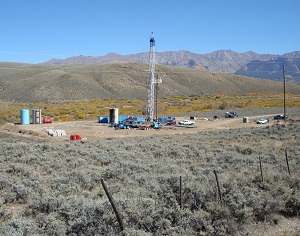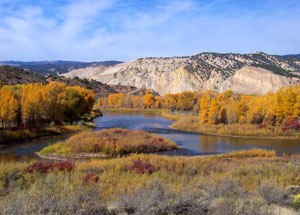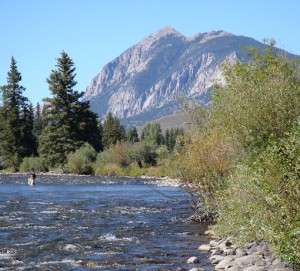Trout Unlimited calls for creative partnerships to keep rivers flowing and healthy.
The U.S. Bureau of Reclamation today released its long-awaited Colorado River Basin Water Supply and Demand Study, a multi-year effort to assess water availability and use in one of the West’s most important river basins. Trout Unlimited called the study a “wake-up call” on the need for greater collaboration on water management and river protection.
“In some respects, the study confirms what many of us are seeing on the ground—drought and changing climate are pressuring our Western rivers as never before,” said Scott Yates, director of TU’s Western Water Project. “We partner with ranchers and farmers along key Colorado tributaries, and it’s a common observation that we’re seeing shorter winters, earlier runoff, hotter temperatures, and lower stream flows during late summer, when crops and fish often need it most. We have to work together to find new, creative ways of managing our water if we want to meet diverse needs and keep our communities, economies, and rivers healthy.”
The BOR study specifically assessed water supply and demand, the ability to potentially balance such supply and demand, and system reliability. The effort included unprecedented river flow and use forecasting and modeling efforts for the Colorado River Storage System (CRSS) – one of the most complex and important federal water storage, delivery, and use systems in the country.
Millions of municipal residents in the West—both in cities and rural areas—depend on the 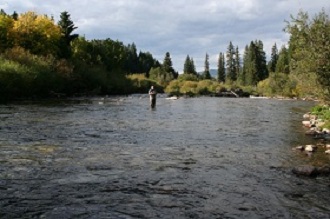 river for daily water use needs, and ranches and farms throughout the seven Colorado River Basin States (Colorado, Wyoming, Utah, New Mexico, Arizona, Nevada, and California) depend on Colorado basin water for their operations. The Colorado River is also a sportsmen’s paradise, with world-renowned trout fishing on popular stretches such as the Upper Colorado near Kremmling, as well as iconic fishing destinations like the Gunnison, Green (including the White and Yampa), Dolores, and San Juan.
river for daily water use needs, and ranches and farms throughout the seven Colorado River Basin States (Colorado, Wyoming, Utah, New Mexico, Arizona, Nevada, and California) depend on Colorado basin water for their operations. The Colorado River is also a sportsmen’s paradise, with world-renowned trout fishing on popular stretches such as the Upper Colorado near Kremmling, as well as iconic fishing destinations like the Gunnison, Green (including the White and Yampa), Dolores, and San Juan.
According to Yates, “If we’re going to have less water because of changing climate—whatever the cause—we need to roll-up our sleeves, develop creative partnerships, and find long-term solutions that help ranchers and farmers upgrade aging infrastructure and improve efficiency while protecting and restoring stream flows and fisheries.”
Trout Unlimited, he noted, already partners with the Bureau of Reclamation and other federal agencies such as the Natural Resource Conservation Service and U.S. Fish and Wildlife Service to help bring innovative irrigation system upgrades to private lands, ranches, and farms—projects that also restore fragmented and depleted streams, benefiting trout habitat and fishing.
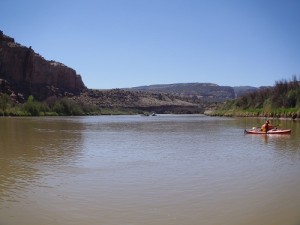 In a region known for its contentious water battles, the Bureau study emphasizes the importance of this emerging collaborative model—diverse stakeholders working together to manage finite water resources to meet the needs of agriculture, industry, towns and cities, and outdoor recreation.
In a region known for its contentious water battles, the Bureau study emphasizes the importance of this emerging collaborative model—diverse stakeholders working together to manage finite water resources to meet the needs of agriculture, industry, towns and cities, and outdoor recreation.
“This is a model that works,” said Yates. “We’ve seen it work across the West in scores of successful win-win partnership projects.”
Trout Unlimited’s Dave Glenn grew up near the Green River in Utah, fishing and hunting in and along one of the West’s great rivers. He said that sportsmen are committed to helping find creative, pragmatic solutions, but they won’t back projects that needlessly destroy high-value fisheries and wildlife habitat.
“Outdoor recreation is a $250 billion a year business in the West,” noted Glenn. “The Bureau study should not be seen as a green light for unrealistic, expensive, and environmentally destructive projects that move water out of their basins of origin,” said Glenn. “TU and other groups have highlighted a range of cheap, pragmatic options— including conservation, reuse, and water sharing—that will meet water needs without sacrificing our rivers and outdoor heritage.”
He added, “Cities can’t meet their water needs on the backs of rural areas, drying up special places like the Green River, and potentially destroying fishing and hunting opportunities.”
“We’re entering an era of water scarcity and fiscal austerity—cooperation and partnerships have to lead the way,” said Yates. “The health of our communities, rural areas and economies flows from healthy rivers. We can’t take them for granted.”
For more information, please contact:
Scott Yates
Director, Western Water Project
syates@tu.org
Dave Glenn
Intermountain Director, Sportsmen's Conservation Project
dglenn@tu.org








